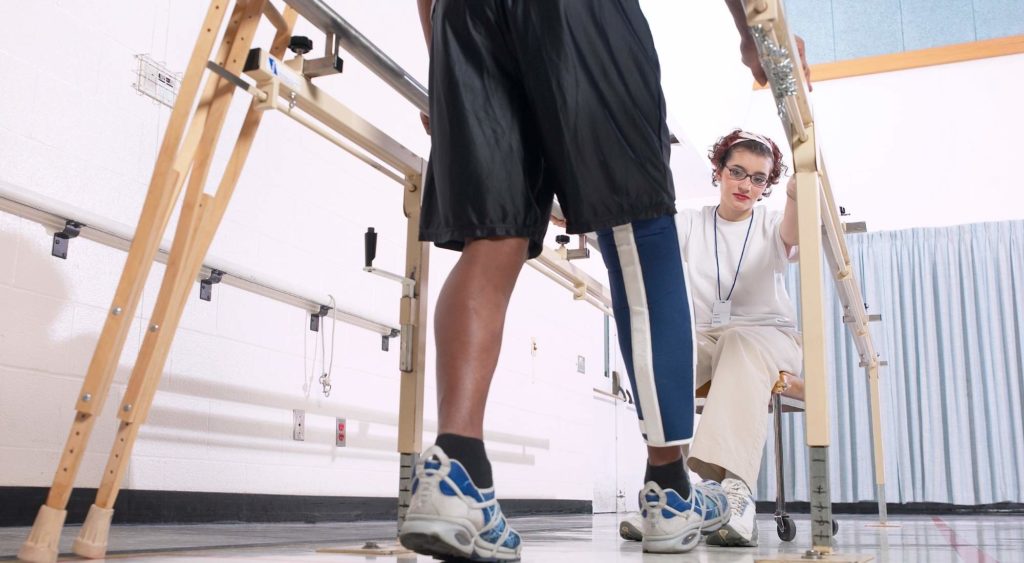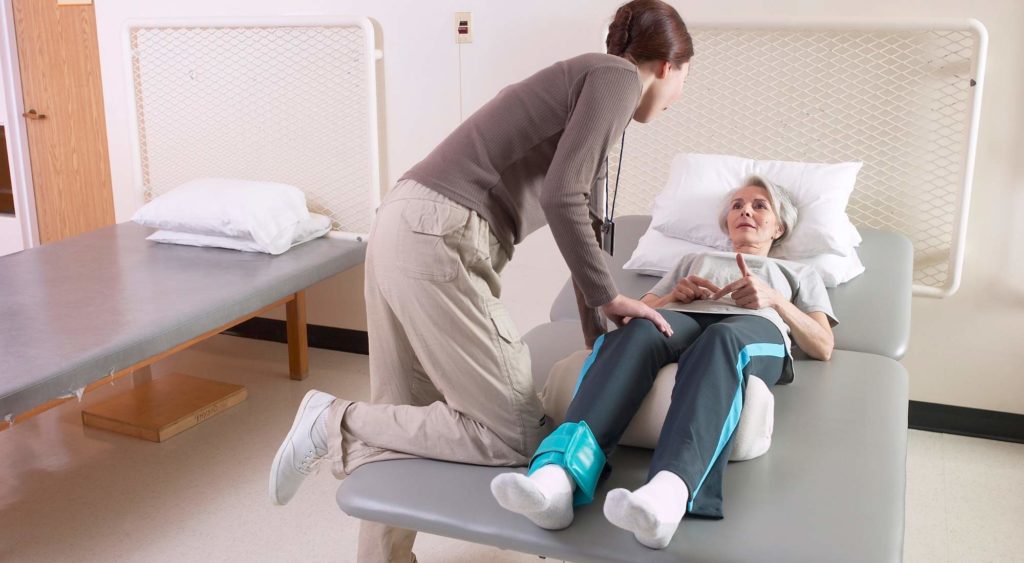
You’ve been diagnosed with multiple sclerosis and aren’t sure of your next steps. Your doctor mentioned PT, but you’re wondering, “How does physical therapy help multiple sclerosis?”
The good news is that it helps in a variety of ways.
In this article, we’ll share with you:
- Why physical therapy is vitally important for MS patients
- How physical therapists can help; and
- Common PT treatments for multiple sclerosis
Keep reading to learn more.
Table of Contents
- Do People With MS Go to Physical Therapy?
- How Do Physical Therapists Help Patients With MS?
- Why Is Physical Therapy Important for Patients With MS?
- 3 Common Multiple Sclerosis PT Treatments
- How Physical Therapy Can Help Patients at Different Stages of MS
- Physical Therapy for Multiple Sclerosis at In Motion O.C.

Do People With MS Go to Physical Therapy?
Yes; if you have MS, you can and should go to physical therapy. MS is a degenerative disease that can be aggressive and progress quickly. Patients who seek out multiple sclerosis physical therapy treatment sooner rather than later may be able to slow the progression and gain more control over their lives.
The pace at which MS advances varies from person to person, but anyone with MS will benefit from starting physical therapy as soon as they are diagnosed.
Regular PT can help MS patients improve their:
- Gait
- Core strength
- Balance
- Flexibility
- Spasticity
- Coordination
- Aerobic Endurance
- Respiratory Function
- And more
Throughout the stages of MS, physical therapy can help you:
- Learn how to deal with your changing body
- Develop stamina and strength
- Avoid making your symptoms worse; and
- Regain your abilities after a relapse
How Do Physical Therapists Help Patients With MS?
Physical therapists play an important part in managing MS throughout the course of the disease. The focus of physical therapy for people with MS is to help maintain and/or return to as normal a life as possible by helping you continue your home, work, and community roles.
Beginning with diagnosis and going through times of progression and stability to relapses and advancement, physical therapists can help every step of the way.
A physical therapist will start with a full evaluation to determine the extent of the:
- Impairments — Such as pain, weakness, and loss of coordination, balance, or sensation
- Activity limitations — Like problems with dressing, walking, or getting into a car
- Participation restrictions — Alterations to your normal routine, such as an inability to cook meals or perform recreational activities
Once this is complete, the therapist will come up with an exercise regimen based on the extent of your condition and your goals. This should include at-home exercises and education.
Why Is Physical Therapy Important for Patients With MS?
If you have MS, physical therapy is crucial to your health and success — and the earlier you get started, the better!
People in the beginning stages of MS may experience changes in their balance, breathing, and walking abilities. Ignoring these problems can quickly lead to further disabilities.
But studies have shown that exercise therapy can begin to combat these effects right away and even slow the progression of the disease.

3 Common Multiple Sclerosis PT Treatments
The most common and effective physical therapy treatments for MS patients are:
- Fitness and exercise programs — This may include tai chi, yoga, and the use of equipment such as treadmills and elliptical machines.
- Aquatic therapy — Exercising in the pool can be ideal, as the buoyancy of the water offers support to people who have trouble walking and gives a gentle resistance to movements.
- General strengthening — Such as building up the arms and legs, stretching activities, balance training, and relaxation techniques.
Exercise programs should be based on each person’s ability and progress as tolerated.
How Physical Therapy Can Help Patients at Different Stages of MS
Multiple sclerosis PT is helpful both with early-onset and as the disease progresses. Let’s look at what you might expect for each stage.
Diagnosis and Early Onset
From the beginning, physical therapists are good at recognizing the disability and finding ways to correct it or compensate for it.
Your therapist will want to complete a baseline evaluation to see how you perform. This will be helpful to compare with your future abilities.
PT helps you retain the habits of being active as much as possible. It allows you to retain more of a normal life by creating a movement strategy plan.
During Periods of Stability
You should be monitored regularly by your physical therapist even during times when the disease does not appear to be progressing.
Consulting with your physical therapist every 3-6 months during times of stability is a good idea — just as you’ll continue to see your medical doctor for check-ups during this time, you can think of seeing your PT as a body tune-up.
Your physical therapist will continue to test your abilities and give you the motivation to continue your exercises at home.
During or After a Relapse
During and after your relapse, your physical therapist wants to help you regain your former level of function.
MS patients lose balance and need to strengthen:
- Core
- Hips; and
- Legs
Targeted training for these areas is crucial. Safely doing cardio and balance exercises will help you during and after a relapse.
Primary Progressive Multiple Sclerosis
If you have primary progressive MS, your disease takes a slow and steady decline rather than having periods of stability and relapse. It is even more important for people with this form of the disease to start physical therapy right away.
Through PT, you’ll learn how to compensate for the bodily changes you’re experiencing. This may include learning how to use a mobility aid like a standing device or wheelchair.
Advanced Multiple Sclerosis
People with advanced MS are usually nonambulatory. But that doesn’t mean they can’t still benefit from physical therapy.
When you have advanced MS, PT can help you:
- Develop upper body strength
- Learn to sit properly; and
- Retain the capacity to use mobility aids

Physical Therapy for Multiple Sclerosis at In Motion O.C.
Physical therapists at In Motion O.C. are available to help treat a variety of ailments, including multiple sclerosis.
As a new patient, you’ll first experience an initial consultation so we can establish your existing impairments and restrictions. Then we’ll use this information to come up with a customized treatment plan just for you.
You’ll want to visit our facilities regularly to help keep your body as strong as possible while your disease progresses and to find compensations for your deficits.
Success for MS through physical therapy comes when patients start as soon as possible. Don’t wait another day.
Contact us now to request a consultation and let’s get you on the road to better health.



